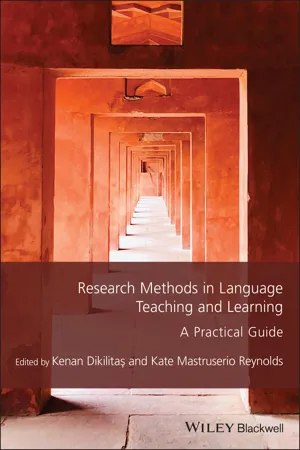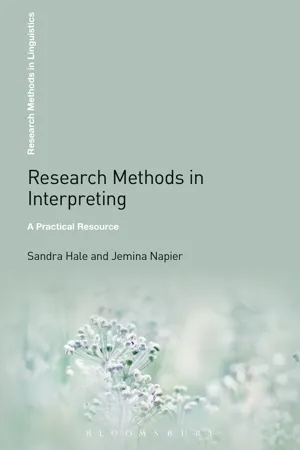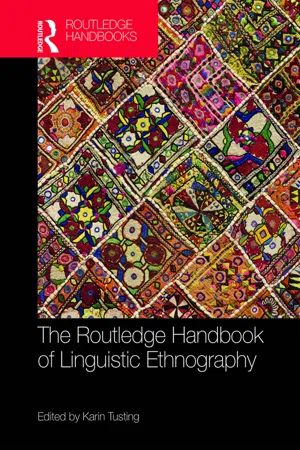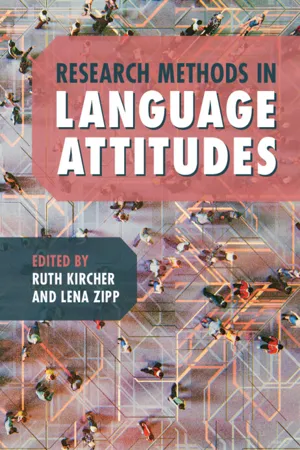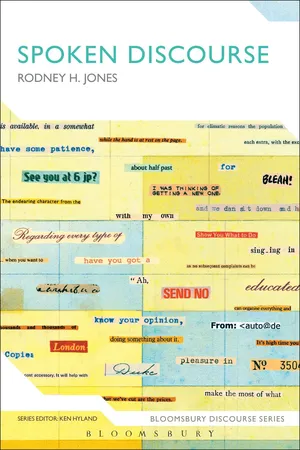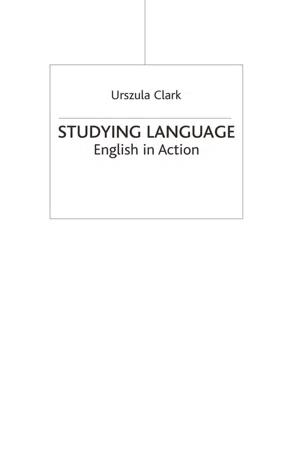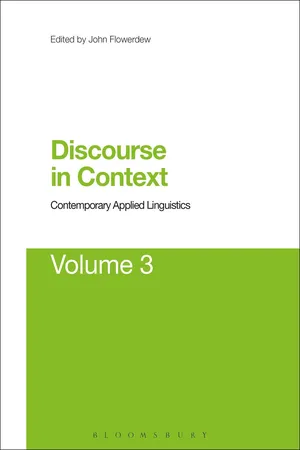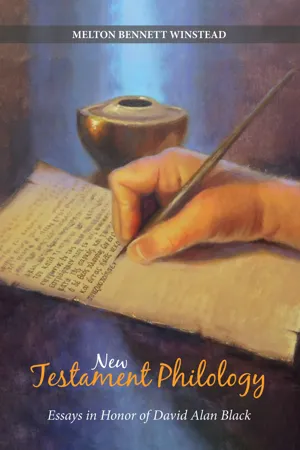Languages & Linguistics
Discourse Analysis
Discourse analysis is the study of language in use, focusing on how language is used to convey meaning in different social contexts. It examines the structure and patterns of communication, as well as the social and cultural factors that influence language use. Discourse analysis helps to uncover underlying meanings and power dynamics within language interactions.
Written by Perlego with AI-assistance
Related key terms
1 of 5
10 Key excerpts on "Discourse Analysis"
- eBook - PDF
Research Methods in Language Teaching and Learning
A Practical Guide
- Kenan Dikilitas, Kate Mastruserio Reynolds, Kenan Dikilitas, Kate Mastruserio Reynolds, Kate Reynolds, Li Wei(Authors)
- 2022(Publication Date)
- Wiley-Blackwell(Publisher)
The concept of discourse with its multidisciplinary nature draws on various areas, such as applied linguistics, sociology, anthropology, and communication (Gee & Handford, 2012; Johnstone, 2008). Especially from a functional view of language, Discourse Analysis can help us better understand how language is used to construct meaning in genuine com-munication. With its interdisciplinary nature and relevance to real purpose of language use, Discourse Analysis as a methodology has caught my attention along with interactional socio-linguistics (Gumperz, 1992). As presented by Gee (2011) in his An Introduction to Discourse 9 Discourse Analysis as a Research Methodology for L2 Context Hatime Çiftçi Discourse Analysis as a Research Methodology for L2 Context 133 Analysis book, one of the major underlying ideas of Discourse Analysis is that “we make or build things in the world through language” (p. 17). He articulates this premise through the concept of seven building tasks: we use language to express significance, be involved in a set of social practices or activities (e.g., advising, informing, and so on), construct an identity, build relationships, express a perspective on the distribution of social goods (e.g., blaming a person or an organization, granting a social good such as being creative, etc.), build connec-tions or relevance, and finally make a specific sign system (e.g., a language or a variety of a language) and knowledge in that system relevant to the context. In that sense, how we build these tasks through the use of language makes certain notions salient for Discourse Analysis. Context, for instance, is one of the fundamental concepts (Cutting, 2008; Gee, 2011) as Discourse Analysis aims to examine the relationship of meaning, form, and function within the social context where language is used, and that is the real communicative activities in everyday life. - eBook - PDF
Research Methods in Interpreting
A Practical Resource
- Sandra Hale, Jemina Napier(Authors)
- 2013(Publication Date)
- Bloomsbury Academic(Publisher)
A more current definition of Discourse Analysis is given by Gee and Handford: Discourse Analysis is the study of language in use. It is the study of the meanings we give language and the actions we carry out when we RESEARCH METHODS IN INTERPRETING 120 use language in specific contexts. Discourse Analysis is also sometimes defined as the study of language above the level of the sentence, of the ways sentences combine to create meaning, coherence, and accomplish purposes (2012, p. 1). Bax, however, argues that the need for the unit of language to be above the sentence is not necessarily valid, as discourse can be text of any size, written, spoken or signed as long as it is authentic and taken in context (2011). So if you decide to use DA as a research method, you must choose how you want to use it. Whatever you decide, however, must be systematic and made clear and transparent in your methodology. Before you embark on any type Discourse Analysis, we recommend you read the seminal publications in the field. We list some of them in Table 5.1 below. Once you have read those, then you will need to read the publications that are specifically on discourse analytical research in Interpreting. We will ask you throughout this chapter to read specific references in connection with the different exercises. 5.4 Conducting Discourse Analysis Because there are so many different forms of Discourse Analysis, it is impossible to provide one single set of guidelines or one single method to conduct DA research. According to Titscher et al., it is ‘. . . more a question of a research strategy than of a single method of text analysis’ (2000, p. 55). Bax (2011) agrees that Discourse Analysis should not be seen as ‘. . . a set of Table 5.1 Seminal references on Discourse Analysis Austin, J. (1962). How to do things with words . Oxford: Oxford University Press. Schegloff, E. and Sacks, H. (1973). Opening up closings. - eBook - PDF
A Discourse Analysis of the Letter to the Hebrews
The Relationship between Form and Meaning
- Cynthia Long Westfall(Author)
- 2006(Publication Date)
- T&T Clark(Publisher)
A. van Dijk and W. Kintsch, Strategies of Discourse Comprehension (New York: Academic, 1985); A. Georgakopoulou and D. Goutsos Discourse Analysis: An Introduction (Edinburgh: Edinburgh University Press, 1997); J. E. Grimes, The Thread of Dis-course (Janua linguarum: Series minor, 207; Hague: Mouton, 1975); M. Hoey, Patterns of Lexis in Text (Describing English Language; Oxford: Oxford University Press, 1991); idem, Textual Interaction: An Introduction to Written Discourse Analysis (London: Routledge, 2001); R. E. Longacre, The Grammar of Discourse (Topics in Language and Linguistics; New York: Plenum Press, 2nd edn, 1996); D. Nunan, Introducing Discourse Analysis (Penguin English Applied Linguistics; London: Penguin, 1993); D. Shiffrin, D. Tannen and H. E. Hamilton (eds), The Handbook of Discourse Analysis (Blackwell Handbooks in Linguistics, Maiden, MA: Blackwell, 2001); M. Stubbs, Discourse Analysis: The Sociolinguistic Analysis of Natural Language (Language in Society, 4; Oxford: Blackwell, 1983). 2. Introduction to Discourse Analysis Theory 23 words or clauses, but looks at the smaller units in their linguistic context. However, it also looks at the text in its social environment, regarding dis-course as involving the speaker/writer and the hearer(s)/listener(s), and their attempt to communicate in situations where language is one of many means of exchange. 2 In simplest terms, Discourse Analysis is the linguistic analysis of texts above the sentence level. 3 J. T. Reed has identified four guiding tenets of Discourse Analysis: 4 (1) Analysis of the production and interpretation of discourse (2) Analysis beyond the sentence (3) Analysis of social functions of language use (4) Analysis of cohesiveness Therefore, Discourse Analysis emphasizes language as it is used. However, in practice, it is an interdisciplinary approach which is still in the early stages of development, demonstrating a bewildering and often contradictory range of terminology and methodology. - eBook - ePub
- Karin Tusting(Author)
- 2019(Publication Date)
- Routledge(Publisher)
While one can historically detect a gradual progression from an early, more narrow linguistic interest in the formal and functional mapping of various aspects of the situated utterance to a later, more process-oriented research perspective which lends priority to social questions such as the connections between language and identity, it is probably more accurate to state that Discourse Analysis has crystallised within language studies in two directions. One can note, on the one hand, a continuation of more linguistic uses of the term, in which discourse is viewed as the layer of meaning which is tied more directly to situations of language use. The focus here is often on large collections of verbal material of a particular situation or activity type and the use of quantitative methods and techniques of corpus linguistics (Biber et al., 2007). Specific discourse-related themes are selected for closer attention (e.g. Warren, 2006 on aspects of naturalness in informal conversational language use). On the other hand, recent decades have witnessed the formulation of a broad project of discourse studies which more holistically views language use, often in combination with other forms of semiotic behaviour, from the angle of ‘social practice’. Much discourse research thus simultaneously attends to aspects of text and talk, processes of interpretation and cognition, and social-actional dimensions of communicative behaviour as well as its functioning at the level of ideological reproduction and socio-cultural transformation.Especially in the latter tradition, Discourse Analysis has often (if not mostly) stood in an applied relationship to the social world, with discourse research oriented to the identification of recommendations for practice (here echoing Brumfit’s definition of applied linguistics as engaged with real-world problems and issues in which language plays a central role (Brumfit, 2001)). A quite arbitrary list which attempts an impression of the range of possible themes could include: contextual complexity in the processing of cartoons by patients with unilateral lesions (Dagge & Hartje, 1985), the effects of story sequencing on affective reactions to news broadcasts (Mundorf & Zillman, 1991), self-commodification in dating advertisements (Coupland, 2006), pedagogical focus in foreign language classrooms and the use of repair strategies (Kasper, 1986), media coverage of the genetically modified food debate (Cook et al., 2006), the communication of rights in contexts of police arrests and detention (Rock, 2007), and so on and so forth. Themes under the heading of registering discourse change in response to shifts in socio-cultural values are also many and varied. One such theme has been the interest in ‘technologies of discourse’ (Fairclough, 1992; Cameron, 2000). - eBook - PDF
- Ruth Kircher, Lena Zipp(Authors)
- 2022(Publication Date)
- Cambridge University Press(Publisher)
Discourse, then, is not simply the ways in which people communicate but a broader semiotic activity which is closely connected with – influencing and influenced by – the social context(s) in which it is produced. It is therefore Discourse Analysis of Print Media 21 heavily involved in ‘producing and maintaining certain identities and power relations’ (Scollon and Wong Scollon 2004: 5). Discourse Analysis can be defined as ‘the use and development of theories and methods which elucidate how this meaning and coherence is achieved’ (Scollon and Wong Scollon 2004: 5). In particular, Discourse Analysis examines spoken or written language in relation to its use in a social context. That is, it examines not only the linguistic features of a language variety or the rules governing the usage of a language variety but also its meaning in context. It involves finding the ‘common-sense’ beliefs or assumptions that are hidden in discourse (Fairclough 2014: 64), describing these assumptions and relating them to the social situation in which they have arisen. CDA is one particular form of Discourse Analysis which aims to ‘reveal what kinds of social relations of power are present in texts both explicitly and implicitly’ (van Dijk 1993: 249), that is, ‘to account for the relationships between discourse and power’ (van Dijk 1995: 84). While CDA is used by a broad range of scholars who have very different backgrounds and somewhat different methods, all agree that social theory and linguistic analysis need to be integrated, often examine similar domains/topics, and are explicitly committed to social action (Blommaert 2005: 24). They also generally have a focus on power, in particular, institutionally reproduced power, and see discourse as an instrument of power. Methodologically, CDA is quite diverse, borrowing and adapting concepts from many research fields (Blommaert 2005: 28). - eBook - PDF
- Rodney Jones(Author)
- 2016(Publication Date)
- Bloomsbury Academic(Publisher)
2 Studying spoken discourse T he study of spoken discourse is an interdisciplinary project that draws on fields such as linguistics, philosophy, anthropology, sociology and critical theory. While, different academic disciplines and the different approaches to discourse that have grown out of them are often based on different assumptions about things like language, society and communication, one thing that unites all of the approaches to spoken discourse that I will review in this chapter is a concern with action . Whereas linguists in the traditions of Saussure and Chomsky are primarily interested in language structures and how they are manifested in the way people speak, discourse analysts start directly with the way people speak and investigate how that affects how they do things in the world. Below I will provide a brief survey of the different academic disciplines that have contributed to the study of spoken discourse and the approaches that have grown out of them. I should mention straight off that there is a great deal of interesting work on spoken discourse that I will fail to mention, and a lot of important ideas that will not find their way into this account. It is not, then, meant to be an exhaustive history of the study of spoken discourse. Rather, what I hope to do is to put the ideas that I will develop in this book in both a disciplinary and a historical context and begin to explore the different epistemologies these ideas promote and the different analytical tools they make available to us. Linguistics Although I begin with the discipline of linguistics, it may come as a surprise to readers that, of all of the disciplines I will be discussing, this is not the one that has contributed the most to the study of spoken discourse, and some linguists have even been downright hostile to many of the methods of studying spoken SPOKEN DISCOURSE 26 discourse that I will describe below. - eBook - PDF
Studying Language
English in Action
- Urszula Clark(Author)
- 2017(Publication Date)
- Red Globe Press(Publisher)
This hypothesis has led to the theory of lin-guistic relativism , and it is this which underlies CDA. ❙ 4.4 Language as discourse The term discourse has several meanings in linguistics. In traditional descrip-tive linguistics, discourse is used to describe manifestations of speech and the term text to describe manifestations of writing. In Discourse Analysis the for-mer is used to describe the physical, aural and visual manifestations of both speech and writing and the study of their management in relation to struc-ture and grammar, taking account of the interaction between speaker and lis-tener and writer and reader, as discussed in Chapters 2 and 3. There is, how-ever, a further meaning of the word, derived from social and cultural theory and particularly from the work of the French social theorist and philosopher Michel Foucault (1972). For Foucault the term discourse applies not only to what is said and written but also to the invisible structures and forces through which the ideas – the ideology – of a society are shaped. These ideas are sub-ject to change, and alter over time. Discourse therefore has two dimensions: a tangible dimension, that is, speech and writing produced from the structures of the language in question; and an intangible one that consists of the underlying assumptions and prac-tices that govern the production of language. Any discourse at any given time is structured as much by the assumptions about what constitutes it as a dis-course as by the boundaries of language itself. As an example Foucault cites institutional practices associated with education. He points out that ‘Every educational system is a political means of maintaining or modifying the appropriateness of discourses with the knowledge and power they bring with them’ (ibid., p. 46). For Foucault, discourses are to do with the ways in which sets of statements are systematically organised in order to give expression to the meanings and values of an institution or a society. - John Flowerdew, Li Wei(Authors)
- 2014(Publication Date)
- Bloomsbury Academic(Publisher)
Similarly, the authors represent different approaches and methods in their analyses, including (in alphabetical order) conversation analysis, corpus linguistics, critical Discourse Analysis, ethnographic Discourse Analysis, mediated Discourse Analysis, multimodal Discourse Analysis and systemic functional linguistics. In juxtaposing the chapters in this way, readers are invited to compare and contrast these different contexts and approaches and the application of their particular models of context. There have been a number of volumes devoted to context in recent decades (Auer and Di Luzio 1992; Fetzer 2004; Duranti and Goodwin 1992), but while certainly relevant to Discourse Analysis, these collections have been written from the perspective of DISCOURSE IN CONTEXT 2 anthropological linguistics, interactional sociolinguistics or pragmatics, rather than being overtly discourse analytic. The present collection is thus, to my knowledge, the first published collection of papers to focus on context from a specifically discourse analytic perspective. Discourse Analysis is concerned with the interpretation of texts and an important part of this analysis is how texts are related to the contexts in which they are produced and received. An understanding of context is thus an essential feature of the analysis. However, while, in its relatively short history, Discourse Analysis has spent a lot of time identifying the structure and functions of the various features which make up text and talk, with notable exceptions, there has been relatively less emphasis on defining just what is meant by context; it has tended to be taken as a ‘given ’. This may be because, as Goodwin and Duranti (1992: 2) state, context is ‘notoriously hard to define’. In spite of the difficulty of pinning down the meaning of the term context , fairly general definitions are to be found.- eBook - ePub
New Testament Philology
Essays in Honor of David Alan Black
- Melton Bennett Winstead, Winstead(Authors)
- 2018(Publication Date)
- Pickwick Publications(Publisher)
576 Even those discourse analytic approaches that champion the distinction between syntax, semantics, and pragmatics must reflect an ideological orientation to reality and the use of language within it, such as action models of language. Many of the approaches noted here have close associations with various types of social-scientific criticism. Almost by definition, Discourse Analysis is a type of social-scientific criticism, in the sense that as an interpretive framework it emphasizes the social and societal role of language, with a text being the product of that role.I think that it is accurate to say that the potential of Discourse Analysis—admittedly some forms of it more so than others—to perform similar interpretive tasks to other exegetical frameworks, while still encompassing other critical elements as well, is a feature that is not reciprocally found within these other interpretive frameworks. If those interpretive frameworks are to include the diversity of interpretive analytics of Discourse Analysis, they would need to adjust their theoretical framework to include various linguistic elements not currently incorporated.2 . ContextThe notion of context is vitally important to a variety of traditional and contemporary approaches to New Testament interpretation. However, that does not mean that these approaches have always been clear on what they mean by context. One of the major trends in New Testament exegesis over the last one-hundred years, as an example, is the shifting exploration of Semitic and Hellenistic backgrounds to the New Testament. This discussion includes a very large and expansive definition of context, that is, context as historical, social, and religious background. Another attempt to define context is what might be called immediate literary or linguistic context. By this, interpreters usually mean the immediate textual environment of the passage, episode, or event under consideration. - eBook - PDF
Social Constructionism
Sources and Stirrings in Theory and Practice
- Andy Lock, Tom Strong(Authors)
- 2010(Publication Date)
- Cambridge University Press(Publisher)
While some focus primarily on aspects of verbal communica- tion (words, metaphors, choice of active and passive voicing, value-laden terms, etc.), others might analyse non-verbal aspects of communications, such as ges- tures or features of vocal presentation. These, in other language, are all forms of semiotic practices. Still other analysts, such as Norman Fairclough ( 1995), focus on the use of a wider range of semiotic resources to pursue particular ideological aims. Most critical discourse analysts prefer to study communicative interaction as it is used to accomplish social purposes in particular contexts. To this end, they analyse these different dimensions of discursive interaction to offer inter- pretations that differ from those of the people and interactions studied. Critical Discourse Analysis sees a link between what we communicate and what we expe- rience, and that we generally regard things the way we do because that is how they are predominantly talked about. Such talking and thinking usually becomes taken for granted, so part of the value of Discourse Analysis is in how it can help us become aware of the link between our taken-for-granted ways of talking and how they shape our thinking. Social Constructionism 276 Critical Discourse Analysis can only make a significant and specific contribution to critical or political analyses if it is able to provide an account of the role of language, language use, discourse or communicative events in the (re)production of dominance and inequality. (van Dijk, 1993: 28) Critical Discourse Analysis (CDA) is a relatively new field of research, which has mostly developed since the early 1990s. Sometimes the term ‘critical linguistics’ is used interchangeably with CDA, and at the heart of CDA is a view that what matters is how language is used in context.
Index pages curate the most relevant extracts from our library of academic textbooks. They’ve been created using an in-house natural language model (NLM), each adding context and meaning to key research topics.
